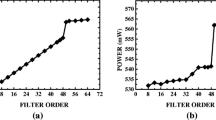Abstract
Significant reductions in FPGA resources, delay, and power can be achieved using truncated multipliers instead of standard parallel multipliers when the full precision of the standard multiplier is not required. With truncated multiplication, the less significant columns of the multiplication matrix are eliminated and correction terms are added to keep the total error to less than one unit in the last place. The truncated multiplication techniques presented in this paper are applied to FPGA parallel multipliers, and can be used in conjunction with a number of other performance enhancing techniques, such as pipelining, Booth encoding, and device specific optimizations to increase the effectiveness of device mapping, placing, and routing.
Access this chapter
Tax calculation will be finalised at checkout
Purchases are for personal use only
Preview
Unable to display preview. Download preview PDF.
Similar content being viewed by others
References
S. Oberman, F. Weber, N. Juffa, and G. Favor, “AMD 3DNow! Technology and the 2 Microprocessor,” in Proceedings of Hot Chips 10, pp. 245–254, 1998.
S. Thakkur and T. Huff, “Internet Streaming SIMD Extensions,” Computer, vol. 32, no. 12, pp. 26–34, 1999.
AltiVec Technology Programming Environments Manual. Motorola, Inc., 1998.
K. Diefendorff, P. Dubey, R. Hochsprung, and H. Scale, “AltiVec Extension to PowerPC Accelerates Media Processing,” IEEE Micro, vol. 20, no. 2, pp. 85–95, 2000.
J. R. Boddie et al., “A 32-Bit Floating-Point DSP with C Compiler,” in Conference Record of the Twenty-Second Asilomar Conference on Signals, Systems and Computers, vol. 2, pp. 880–884, 1989.
N. Vasseghi, K. Yeager, E. Sarto, and M. Seddighnezhad, “A 200-MHz Superscalar RISC Microprocessor,” IEEE Journal of Solid-State Circuits, vol. 31, no. 11, pp. 1675–1686, 1996.
R. Weiss, “32-Bit Floating-Point DSP Processors,” EDN, vol. 36, no. 23, pp. 127–146, 1991.
M. Thornton, J. Gaiche, and J. Lemieux, “Tradeoff Analysis of Integer Multiplier Circuits Implemented in FPGAs,” in IEEE Pacific Rim Conference on Communications, Computers and Signal Processing, pp. 301–304, 1999.
Lucent Technologies, “Implementing and Optimizing Multipliers in ORCA FPGAs,” Technical Application Note, 1997.
D. McCarley, S. Megeed, and J. Fried, “Module Generated Multipliers in Field Programmable Gate Arrays,” Lehigh University Technical Report, 1999.
A. V. Oppenheim and R. W. Schafer, Digital Signal Processing. Prentice-Hall, Inc., 1975.
M. J. Schulte and E. E. Swartzlander, Jr., “Truncated Multiplication with Correction Constant,” in VLSI Signal Processing, VI, pp. 388–396, 1993.
E. J. King and E. E. Swartzlander, Jr., “Data-Dependent Truncated Scheme for Parallel Multiplication,” in Proceedings of the Thirty First Asilomar Conference on Signals, Circuits and Systems, pp. 1178–1182, 1998.
M. J. Schulte, J. G. Jansen, and J. E. Stine., “Reduced Power Dissipation Through Truncated Multiplication,” in IEEE Alessandro Volta Memorial International Workshop on Low Power Design, pp. 61–69, 1999.
L. Dadda, “Some Schemes for Parallel Multipliers,” Alta Frequenza, vol. 34, pp. 349–356, 1965.
Lucent Technologies, “ORCA OR3LxxxB Series Field-Programmable Gate Arrays,” Product Brief, 1999.
Lucent Technologies, “ORCA OR3LxxxB Series Field-Programmable Gate Arrays,” Data Addendum, 1999.
Author information
Authors and Affiliations
Editor information
Editors and Affiliations
Rights and permissions
Copyright information
© 2001 Springer-Verlag Berlin Heidelberg
About this paper
Cite this paper
Wires, K.E., Schulte, M.J., McCarley, D. (2001). FPGA Resource Reduction Through Truncated Multiplication. In: Brebner, G., Woods, R. (eds) Field-Programmable Logic and Applications. FPL 2001. Lecture Notes in Computer Science, vol 2147. Springer, Berlin, Heidelberg. https://doi.org/10.1007/3-540-44687-7_59
Download citation
DOI: https://doi.org/10.1007/3-540-44687-7_59
Published:
Publisher Name: Springer, Berlin, Heidelberg
Print ISBN: 978-3-540-42499-4
Online ISBN: 978-3-540-44687-3
eBook Packages: Springer Book Archive




